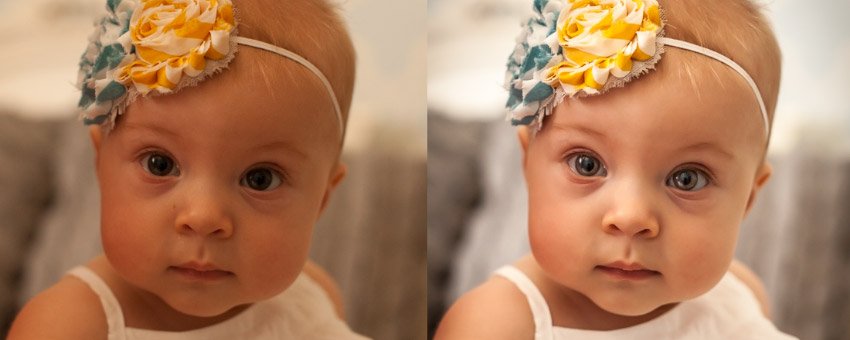Natural Light Baby Portrait Editing Lightroom Workflow

Watch Video Tutorial
Download full HD videos and tutorial project files with a PanoPass. You'll also get instant access to everything on the site, including products, and more.
Sometimes the best photo moments are captured in a flash, but without using a flash. With the advent of RAW photo editing, it's easy to turn an underexposed, dull photo into a print ready portrait.
This tutorial will walk you through my workflow in this exact situation. The moment was beautiful, the initial photo, not so much.
Step 1
The first thing I like to do is adjust the White Balance. This photo came out a bit too yellow, so I'm going to reduce the white balance from 6250 to 5000.

Step 2
The skintones in the image are a bit dark, so next I'll increase the exposure by about +.85.

Step 3
I want to increase the contrast in my image a bit, so I'll increase the Clarity to +65.

Step 4
After increasing the Clarity, some items in the image like the eyes are too dark, so I'll increase the Shadows to +80.

Step 5
Now that we've brought up the Shadows, some of the darkest bits of the image are a bit too bright. We can fix that by lowering the Blacks to -15, which will darken only the very darkest portions of the photo.
It's a subtle change, but will help the final photo from looking washed out.

Step 6
Based on the subject matter in this image, I want the brightest parts of the image to really shine, so I'll increase the Whites to about +35.

Step 7
To further enhance the brightest whites in my image, I'll open the Tone Curve panel and make some adjustments.
I set the right stop of the curve all the way to the right, then set the Highlights to +15.

Step 8
In a portrait like this, I like sharp edges but soft skin, which I'll make happen in the Details panel.
Within the Details panel, I'll set the Sharpening Amount between 75-100, then set the Luminance slider to about 50.

Step 9
Under the Lens Corrections panel, I'll enable Profile Corrections, and make sure the Remove Chromatic Abberation checkbox is checked. This will remove any camera lens vignetting and distortion.
The effect is subtle, but each little edit adds up to a lot.

Step 10
I like pretty strong vignettes in my photos, so under the Effects panel, I'll set the Post-Crop Vignette Amount to -30. Then I'll set the Midpoint to 60 so my vignette doesn't reach so far into the image.

Step 11
With the spot removal tool, I'll zoom in on the face and remove any spots that shouldn't be there.

Step 12
Another thing I like to do is brighten up the eyes just a bit. To do so, I'll just paint over the eyes with the Adjustment Brush tool and set the Exposure to about +0.5 and the Saturation to about 10.

Before and After
As you can see, each small step leads up to a greatly transformed final image.

Did seeing this workflow help you in your own work? Share your edits in the comments.
